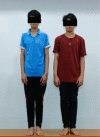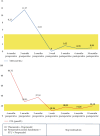Central Hyperthyroidism due to Thyroid-Stimulating Hormone-Secreting Pituitary Microadenoma in an Adolescent Boy: Case Report and Review of the Literature
- PMID: 34336310
- PMCID: PMC8317470
- DOI: 10.1155/2021/5573231
Central Hyperthyroidism due to Thyroid-Stimulating Hormone-Secreting Pituitary Microadenoma in an Adolescent Boy: Case Report and Review of the Literature
Abstract
Thyroid-stimulating hormone- (TSH-) secreting pituitary adenoma (TSH-oma) is a rare cause of secondary hyperthyroidism and can be misdiagnosed as primary hyperthyroidism. We report a case of a 15-year-old male patient who was one of two monozygotic twins and exhibited hyperthyroidism syndrome. The laboratory results showed secondary hyperthyroidism, with increased levels of free T3 (FT3) and free T4 (FT4) and no TSH inhibition. Magnetic resonance imaging (MRI) and histopathological examination of the pituitary gland confirmed pituitary microadenoma. The patient was treated with methimazole, propranolol, and somatostatin analogs to restore euthyroidism before undergoing an endoscopic transsphenoidal resection of the pituitary tumor. After surgery, the hyperthyroidism symptoms improved, thyroid hormones normalized, and MRI of the pituitary gland showed the complete removal of the tumor with no recurrence after 2 years of follow-up.
Copyright © 2021 Le Hoang Bao et al.
Conflict of interest statement
The authors declare no conflicts of interest.
Figures




Similar articles
-
Macro- and microadenoma of thyrotropin secreting pituitary tumors--two clinical cases.Przegl Lek. 2003;60(11):768-71. Przegl Lek. 2003. PMID: 15058054
-
Ectopic pituitary adenoma of the TSH-secreting sphenoidal sinus with excellent response to somatostatin analogs. Theory of the embryogenesis and literature review from a clinical case.Steroids. 2020 Feb;154:108535. doi: 10.1016/j.steroids.2019.108535. Epub 2019 Nov 6. Steroids. 2020. PMID: 31704334 Review.
-
Clinicopathological characteristics and therapeutic outcomes in thyrotropin-secreting pituitary adenomas: a single-center study of 90 cases.J Neurosurg. 2014 Dec;121(6):1462-73. doi: 10.3171/2014.7.JNS1471. Epub 2014 Sep 19. J Neurosurg. 2014. PMID: 25237847
-
Ectopic TSH-secreting pituitary tumor: a case report and review of prior cases.BMC Cancer. 2014 Jul 28;14:544. doi: 10.1186/1471-2407-14-544. BMC Cancer. 2014. PMID: 25069990 Free PMC article.
-
A thyrotropin-secreting macroadenoma with positive growth hormone and prolactin immunostaining: A case report and literature review.Niger J Clin Pract. 2015 Sep-Oct;18(5):693-7. doi: 10.4103/1119-3077.158983. Niger J Clin Pract. 2015. PMID: 26096253 Review.
Cited by
-
A Case Report of a Thyrotropin-Secreting Pituitary Macroadenoma.Cureus. 2022 Jul 25;14(7):e27216. doi: 10.7759/cureus.27216. eCollection 2022 Jul. Cureus. 2022. PMID: 36035030 Free PMC article.
References
-
- Beck-Peccoz P., Lania A., Persani L. Endocrinology . 7th. Philadelphia, PA, USA: W.B. Saunders Ltd; 2015. Chapter 24. TSH-producing adenomas; pp. 266––274.
Publication types
LinkOut - more resources
Full Text Sources

